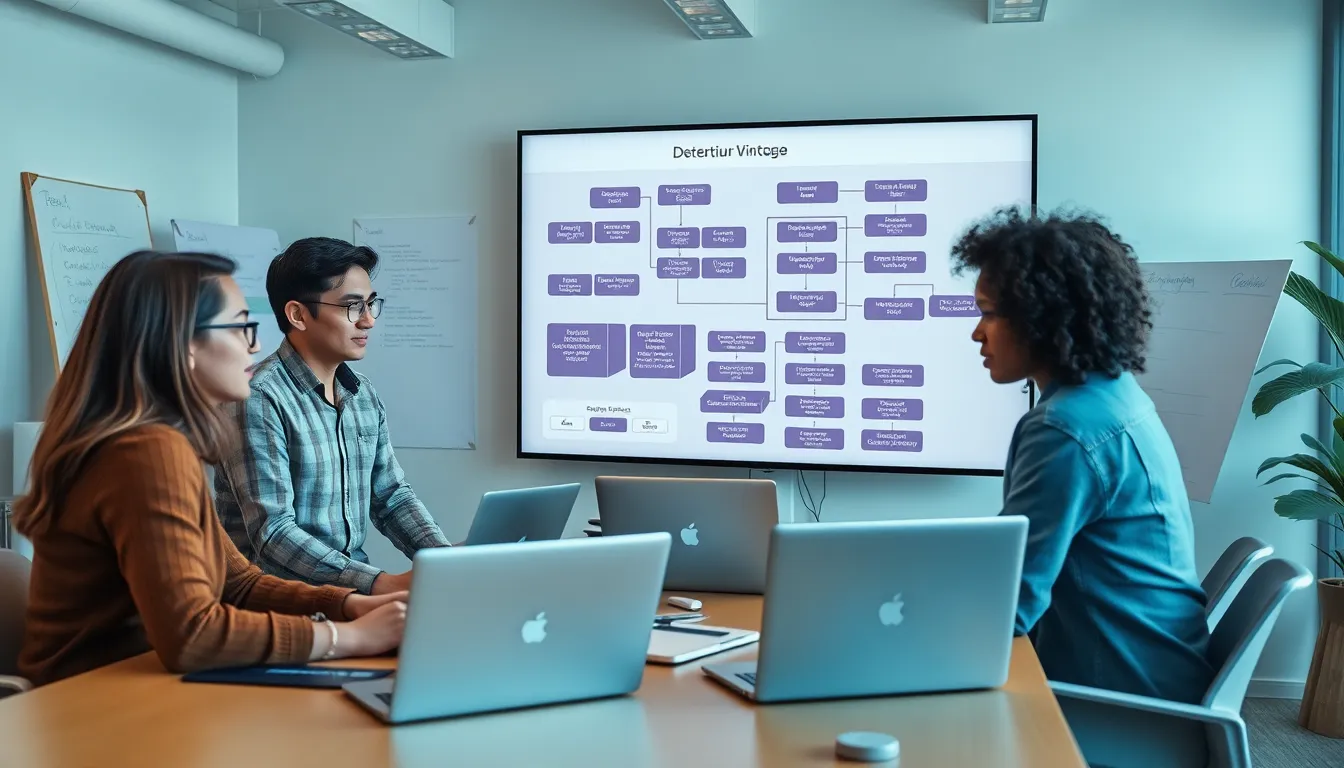Table of Contents
ToggleIn a world where software delivery can feel like herding cats, the DevOps roadmap emerges as a guiding star. It’s the secret sauce that turns chaotic code releases into smooth deployments, making developers and operations teams dance in perfect harmony. If you’ve ever wondered how to transform your tech chaos into a well-oiled machine, you’re in the right place.
Navigating the DevOps landscape might seem daunting, but fear not—this roadmap is your trusty GPS. It’ll help you avoid the potholes of miscommunication and the speed bumps of inefficiency. So buckle up and get ready to explore the essential steps that’ll propel your organization into the fast lane of continuous integration and delivery. With a sprinkle of humor and a dash of professionalism, this guide will make mastering DevOps not just achievable but downright enjoyable.
Overview of DevOps Roadmap
A DevOps roadmap presents a structured approach that enhances software delivery. This framework transforms the chaotic process of code releases into a systematic, efficient deployment pipeline. Organizations find this roadmap essential for navigating the complexities inherent in DevOps.
Key components of the DevOps roadmap include continuous integration, continuous deployment, and automated testing. Fostering collaboration between development and operations teams plays a critical role. Establishing a culture that prioritizes communication reduces miscommunication and boosts efficiency.
The roadmap outlines stages such as planning, development, testing, release, deployment, and monitoring. Each stage builds upon the previous one, creating a smooth flow of processes. Prioritization at each stage ensures that organizations focus on delivering quality software.
Implementing tools like version control systems, CI/CD pipelines, and containerization platforms stands at the forefront of the roadmap. Each tool supports automation, increasing speed and reliability in deployments. Organizations can monitor performance using observability tools, fostering a culture of continuous improvement.
Adopting feedback loops during the development process enables teams to quickly address issues. These loops facilitate ongoing communication and collaboration, enhancing product quality. Emphasizing training and skill development prepares teams for challenges ahead.
Ultimately, the DevOps roadmap serves as a vital guide to not only streamline software delivery but also cultivate a culture of collaboration and innovation. Following this roadmap leads organizations toward more efficient deployments and improved overall performance.
Key Components of DevOps Roadmap

The DevOps roadmap includes essential components that contribute to effective software delivery and team collaboration.
Culture and Collaboration
Collaboration between development and operations teams plays a vital role in a successful DevOps culture. This culture encourages open communication and shared responsibilities. Organizations that prioritize collaboration see reduced miscommunication and increased efficiency. Implementing regular team meetings fosters transparency and addresses challenges quickly. Moreover, creating cross-functional teams enhances knowledge sharing and problem-solving capabilities. Building a culture of trust empowers teams to experiment and innovate, which can lead to improved product quality over time.
Tools and Technologies
Various tools and technologies support the implementation of a DevOps roadmap. Version control systems like Git enable teams to manage code collaboratively and track changes effectively. CI/CD pipelines automate the integration and deployment processes, increasing release frequency and reducing manual errors. Containerization platforms, such as Docker and Kubernetes, simplify application deployment and scaling. Monitoring tools enhance observability, allowing teams to assess performance in real-time. Ultimately, selecting the right tools aligns with organizational goals and accelerates software delivery.
Practices and Processes
Adopting best practices and streamlined processes is essential in DevOps. Continuous integration ensures that code changes are frequently integrated, leading to early detection of issues. Automated testing minimizes human error and accelerates the feedback loop, enhancing overall product stability. Regularly reviewing and refining deployment processes contributes to improved efficiency and reliability. Incorporating feedback loops during development allows teams to adapt swiftly to changing requirements. Prioritizing these practices cultivates a proactive environment that supports continuous improvement across the software development lifecycle.
Stages of the DevOps Journey
The DevOps journey consists of several critical stages, each essential for achieving successful software delivery and operational efficiency. Each stage contributes to refining processes and enhancing collaboration between development and operations teams.
Planning
Planning lays the foundation for successful projects. Prioritizing requirements and defining goals helps teams align their objectives. It’s crucial to analyze customer needs to design features that provide maximum value. Collaboration during this phase improves communication among stakeholders. Utilizing tools like Jira or Trello can track tasks and monitor progress. Documentation in planning stages sets clear expectations for all parties involved. Establishing metrics for success ensures accountability throughout the project lifecycle.
Development
Development focuses on writing and integrating code efficiently. Code quality needs consistent attention as functionality evolves. It’s vital to adopt version control systems like Git to manage changes effectively. Encouraging pair programming enhances skill sharing among team members. Regular code reviews increase accountability and maintain quality standards. Continuous integration practices enable teams to detect issues early. Emphasizing automation in building processes accelerates development cycles, ensuring faster delivery.
Testing
Testing verifies that the software meets quality standards. Implementing automated testing frameworks helps identify bugs quickly and accurately. Integrating testing within the development process enhances feedback loops. It’s essential to ensure comprehensive coverage, including unit tests, integration tests, and acceptance tests. Running tests in parallel with development minimizes delays and keeps the project on track. Frequent testing promotes confidence in code stability. Continuous feedback boosts overall product quality, preparing the software for deployment.
Deployment
Deployment involves delivering software updates to users effectively. Adopting continuous deployment practices reduces lead time for new features and fixes. Automated deployment tools streamline the release process, minimizing human errors. Implementing rollback strategies ensures quick recovery from issues post-release. Monitoring user feedback immediately after deployment provides insights into performance. Engaging stakeholders during this phase ensures alignment with business objectives. Prioritizing security and compliance checks guarantees that deployed software meets regulatory standards.
Monitoring
Monitoring tracks software performance and user experience continuously. Real-time monitoring tools identify issues proactively, allowing teams to react swiftly. Establishing key performance indicators helps measure success and facilitate data-driven improvements. Collecting feedback from users supports ongoing product enhancements. Collaboration between development and operations teams fosters a culture of continuous improvement. Reviewing logs and metrics regularly maintains system reliability. Transitioning insights from monitoring into actionable strategies promotes sustainable growth.
Essential Skills for DevOps Professionals
DevOps professionals require a blend of technical and soft skills to succeed in a dynamic environment.
Technical Skills
Familiarity with cloud platforms like AWS, Azure, or Google Cloud remains crucial. Proficiency in scripting languages such as Python or Bash streamlines automation tasks. Understanding containerization tools like Docker and orchestration platforms such as Kubernetes enhances deployment efficiency. Knowledge of CI/CD tools, including Jenkins and GitLab, facilitates continuous integration and delivery processes. Experience with version control systems, primarily Git, ensures effective code management. Test automation frameworks like Selenium help maintain software quality. Monitoring tools such as Prometheus or Grafana provide insights into system performance. Familiarity with infrastructure as code tools like Terraform supports seamless resource management.
Soft Skills
Effective communication skills bolster collaboration between teams. Adaptability helps professionals navigate and adjust to rapid changes and emerging technologies. Problem-solving abilities allow teams to address unforeseen challenges quickly. Teamwork fosters a collaborative culture essential for achieving shared goals. Conflict resolution skills become vital when managing differing opinions or approaches. Time management ensures that professionals prioritize tasks effectively and meet deadlines. Continuous learning fosters a proactive attitude toward acquiring new skills and staying current with industry trends. Leadership qualities inspire and motivate teams to achieve performance excellence.
Embracing the DevOps roadmap is essential for organizations aiming to enhance their software delivery processes. By following its structured approach and focusing on continuous integration, deployment, and testing, teams can significantly improve efficiency and reduce miscommunication.
The integration of key tools and best practices fosters a culture of collaboration and innovation. This not only streamlines operations but also ensures a commitment to quality and performance.
As organizations continue their DevOps journey, prioritizing both technical and soft skills will empower teams to adapt and thrive in a rapidly evolving landscape. With the right roadmap in place, the path to successful software delivery becomes clearer and more attainable.




